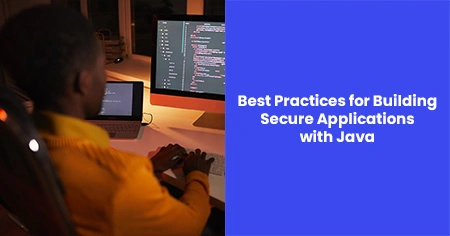Industry studies show automated scanners hit every public-facing server within minutes of a new CVE disclosure, so hoping to “fix it later” is no longer realistic. Forward-looking teams begin threat modelling during sprint planning, enforce static analysis in continuous integration, and, crucially, hire dedicated Java developer talent that sees safety as a functional feature. This article explains why security-minded engineers are worth the investment, lists concrete practices they must apply, and shows a step-by-step approach for recruiters who want to build a top-tier secure development group.
Why You Should Hire Java Developers with Security Expertise
The cost of insecure code is felt in boardrooms as well as backend logs. A single leaked S3 bucket can invite class-action lawsuits and executive resignations. Worse, emergency patches derail product road-maps: development time shifts from new features to after-hours incident response. Engineers who understand secure coding principles prevent that chaos before it starts.
Unlike generalists, specialists in application security embed defence into design choices. They refuse to rely on implicit trust between microservices, insisting instead on mutual TLS. During code review, they flag orphaned feature toggles that expose deprecated endpoints. They also keep up with Java-specific hazards such as gadget chains in native serialization and the risks of invoking JNDI lookups in untrusted data. Their toolbelt contains more than IDE shortcuts: they run Dependency-Check against every Maven build, write property-based tests that explore edge cases, and maintain detailed threat models as living documents.
Credentials offer shorthand evidence. Familiarity with OWASP’s Top Ten indicates up-to-date web risk awareness, while the CSSLP demonstrates knowledge of secure software life cycles. Practical contributions, however — such as submitting a pull request that tightens default cipher suites in an open-source library or disclosing a logic flaw through a responsible-disclosure program — carry the most weight. Companies that bring in Java developers for hire who possess that mix of learning and real-world wins discover that audits become routine paperwork instead of nerve-wracking fire drills.
Core Security Practices Every Team of Java Developers for Hire Should Follow
Even elite engineers need structure. A consistent checklist turns personal diligence into an organisational standard and protects the codebase when staff rotate. Before the first user story is estimated, architects document the data-flow diagram and identify trust boundaries. During the sprint, pair programming and mandatory branch protections ensure at least two sets of eyes examine every change. After deployment, runtime observability alerts developers when a supposedly unreachable path suddenly receives traffic.
Below is the single list you should demand to hire Java programmers respect on every project, whether they work in-house or via an agency:
- Input validation and output encoding: All external data — HTTP parameters, JDBC results, message-queue payloads — passes through an allow-list validator. Outputs are escaped in context so a valid username cannot break HTML, JSON, or shell scripts.
- Safe persistence: Queries never concatenate strings. Prepared statements or a hardened ORM handle variables, stripping database privileges from the application role to limit damage if compromised.
- Serialization hygiene: Binary serialization is replaced by JSON-B, Jackson, or Protocol Buffers. Where legacy components require Serializable, ObjectInputFilter whitelists limit accepted classes and block gadget chains.
- Correct use of JCA and JCE: Keys come from SecureRandom, encryption defaults to AES-GCM or ChaCha20-Poly1305, and asymmetric operations use RSA-OAEP or ECDSA. Secrets live in HSMs, never in source control or plain-text environment variables.
- Least privilege enforcement: Spring Security or JAAS assigns a separate principal for every service and scheduled job. Human administrators use MFA, short-lived tokens, and just-in-time elevation rather than always-on super-accounts.
- Dependency management discipline: The build fails when OWASP Dependency-Check finds a critical CVE. Artifacts are signed with Sigstore; a software bill of materials accompanies each release to satisfy supply-chain regulations.
- Hardened runtime: Containers run JVMs as non-root users inside distroless images, attach minimal capabilities, and set defensive flags such as -Djava.security.properties=/app/security.props. Infrastructure-as-code templates enforce the same controls in every environment.
Teams that internalise these seven points notice fewer late-cycle surprises, because the most common exploit vectors are blocked long before the code hits production.
How to Hire Java Developers Who Can Build Secure Applications
Recruitment can feel overwhelming when résumés pile up, but a disciplined funnel avoids wasted interviews. Start with a job description that makes security non-negotiable. Phrases like “owns threat modelling workshops,” “maintains SAST rules,” and “responds to audit findings” filter candidates who enjoy that responsibility.
During résumé triage, skip keyword matches alone. Focus on measurable outcomes: “Eliminated 1,200 high-severity SonarQube issues in three months” or “Deployed mutual TLS across forty microservices with zero downtime.” Applicants who speak at local OWASP chapters or publish vulnerability write-ups show passion that no certification can fake. When portfolios arrive, request code samples plus architecture notes. A small Git repository that implements a REST endpoint and includes a markdown threat model reveals far more than a polished slide deck.
Screening interviews follow a deliberate path. First, a system-design segment asks the candidate to sketch a secure onboarding process for a fintech platform. Look for reasoning about secrets management, tenant isolation, and event-driven audit logging. Next comes a live-coding exercise: provide a broken Spring Boot controller that mishandles user input and ask the engineer to patch it, write tests, and explain how they would automate the check. Finally, explore past post-mortems: strong developers describe how they discovered root cause, persuaded stakeholders to fix underlying processes, and prevented recurrence.
Sourcing matters, too. University capture-the-flag teams produce graduates comfortable with offensive tactics who can translate that knowledge into defensive coding. Specialist recruiting firms maintain vetted pools of security engineers. Internal referral bonuses encourage existing staff to recommend peers who already share the organisation’s culture and tooling habits. Following this structured approach answers how to hire Java developers who reduce risk rather than merely write features.
Retention deserves equal attention. Skilled security engineers value continuous learning, so allocate budget for conference travel and give them time to contribute patches upstream. Pair them with product teams early in the design cycle to avoid “security as gatekeeper” resentment. A culture where cross-functional squads celebrate closed CVEs during sprint reviews keeps morale high and turnover low.








